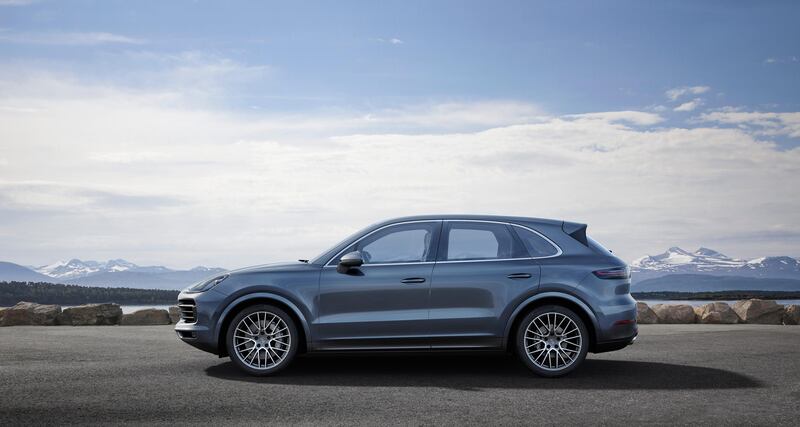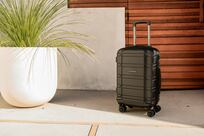Porsche stylists have made an art form of incremental evolution. Need proof? Stand a 911 from 1963 next to a 2017 model. The latest rear-engined bitumen burner is significantly longer, wider and squatter, and its styling is bang up to date, yet the familial link to its ancestor is unmissable.
The same goes for the Cayenne, recently unveiled in third-generation guise (it lands in UAE showrooms in January). Although seemingly a face-lifted version of the outgoing model, everything under the skin is genuinely all-new.
So what is it with the ultra-cautious approach to styling these days? Rival manufacturers are playing a similar game, whereby the current iterations of their saloons and SUVs appear nothing more than cosmetically upgraded versions of the vehicles they replace.
There is a strong emphasis on plastering a "family face" across their offerings, so much so that it is hard to differentiate a C-Class, an E-Class and an S-Class from 50 paces; or an Audi A4, A6 and A8; or a Jaguar XE and XF.
For the manufacturers in question, it is all about brand building and retaining the buyers who have contributed to their sales success.
These customers want to feel like they're not just buying a vehicle, but acquiring a slice of a carefully cultivated heritage.
This is largely why the prestige brands, in particular, have adopted what seems like a template formula to their products' design language. Their aim is to stamp the marque's identity home at first glance.
In the case of the latest Cayenne, although it looks outwardly like a nip-tucked version of the oldie, rest assured it is a cutting-edge offering likely to again set the dynamic benchmark for SUVs – at least until the Lamborghini Urus barges in early next year.
The Cayenne's surprise-and-delight features include a sophisticated (optional) adaptive air suspension system that promises a massive bandwidth between the two polarities of ride comfort and razor-sharp handling.
It also sports the clever active electric anti-roll bar (keeping the car flat under hard cornering) used by the massively weighty yet surprisingly agile Bentley Bentayga.
What about off-road ability, you ask? It is a fair question, but a largely irrelevant one in the modern context, because you're hardly likely to see many Cayennes blasting across sand dunes or attempting to crawl over boulders. There is a far greater probability of them turning up at track days, hustling around the circuit at a pace congruent with a decent sports saloon.
That said, if you were really intent on dune-bashing your Cayenne, it would fare OK if you removed the front spoiler and ditched the XXL rims and low-profile rubber, and replaced them with a set of 18-inchers and all-terrain tyres.
During the vehicle's development phase, Porsche's engineers thrashed it on the UAE dunes and gave it their seal of approval. There is certainly no shortage of power: the entry-level Cayenne (which will cost from Dh298,300) packs a 340hp punch from its 3.0-litre turbo engine.
Meanwhile, the Cayenne S (from Dh363,200) scores essentially the same 2.9L twin-turbo V6 as the Audi RS 5 we reviewed recently, but it is tuned to eke out 440hp – sufficient to propel it from 0 to 100kph in 4.9 seconds and hit 265kph flat out.
It doesn't end there – even-more-potent V8 versions of the Cayenne are in the not-too-distant pipeline.
The new Cayenne does raise the subject of how Porsche has transitioned from being a sports-car manufacturer to a maker of SUVs?
OK, that's a slight exaggeration. The Zuffenhausen-based concern still makes sports cars. After all, the 911 is its poster car – even though the evergreen sportster is now in its 54th year. And there is also the sublimely balanced 718 Boxster/Cayman and recently revamped Panamera saloon.
But the fact remains that Porsche now derives about 70 per cent of its sales from the Macan and Cayenne, so it is not a complete misrepresentation to describe it as primarily an SUV company.
If further proof was needed that the top brass in Stuttgart made an astute call in diversifying its line-up with the controversial (at the time) Cayenne in 2003, this is it.
The metamorphosis that Porsche has made is, to a certain extent, reflected by almost every other prestige marque, because they have all had to cater to changing market demands by bolstering their model ranges with one, two or more SUVs.
It is just that the shift has been far more dramatic at Porsche than at any other brand.
One factor that makes the whole SUV-building caper a highly attractive one for Porsche is that the company can drastically reduce development/production costs by sharing platforms, power plants and transmissions with other brands in the Volkswagen Group. Obviously, that isn't the case with the 911 and 718 Boxster/Cayman, which share almost zero with any other model.
However, when it comes to the latest Cayenne, the "MLB Evo" architecture it is built on already features in the Bentley Bentayga and Audi Q7, and the upcoming Lamborghini Urus and next-gen VW Touareg also use this platform.
The net result? A very tidy windfall for Porsche's bean counters.
_______________
Read more:
Vintage Porsche among Abu Dhabi Police's new look vehicles
[ Dubai's Car Vault is banking on luxury vehicles ]
[ The Arabian Gazelles: Meet the UAE's first women-only luxury and supercar club ]
_______________






